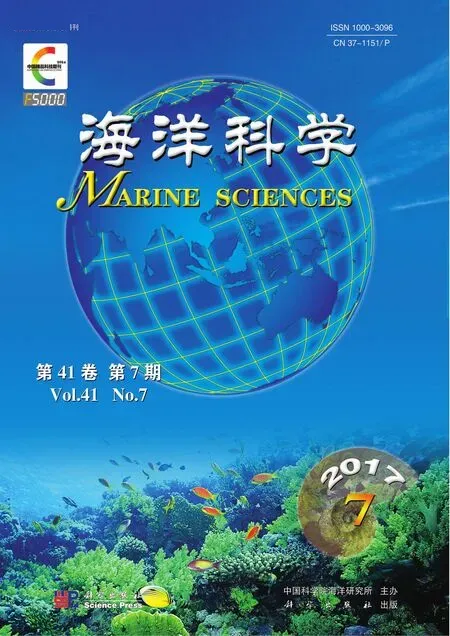黄姑鱼胚胎发育及其与温度和盐度的关系
2017-11-21黄贤克单乐州闫茂仓柴雪良胡利华邵鑫斌
黄贤克, 单乐州, 闫茂仓, 柴雪良, 胡利华, 邵鑫斌
黄姑鱼胚胎发育及其与温度和盐度的关系
黄贤克1, 2, 单乐州1, 2, 闫茂仓1, 2, 柴雪良1, 2, 胡利华1, 2, 邵鑫斌1, 2
(1. 浙江省海洋水产养殖研究所, 浙江温州 325005; 2. 浙江省近岸水域生物资源开发与保护重点实验室, 浙江温州 325005)
为研究温度和盐度对黄姑鱼()胚胎发育的影响, 作者观察了黄姑鱼受精卵的形态和胚胎发育过程。实验结果表明, 温度18~28℃范围内, 温度对孵化时间和初孵仔鱼有显著影响, 对孵化率影响不大, 24~28℃是黄姑鱼胚胎发育的适宜温度范围; 盐度低于24时受精卵下沉, 26~28内悬浮于水体中, 盐度高于34时受精卵浮于水面; 黄姑鱼胚胎发育的最适盐度范围26~32, 盐度超过或低于其适宜范围时, 孵化率明显下降或者幼虫畸形率明显增大。另外, 根据其10值推算的胚胎发育的适宜水温与实验结果相似。
黄姑鱼(); 胚胎发育; 温度; 盐度
黄姑鱼()属石首鱼科(Sciaenidae), 黄姑鱼属(), 为近海暖温性中下层经济鱼类, 分布于中国、朝鲜半岛和日本南部沿海, 是中国重要的经济鱼类[1]。迄今, 有关黄姑鱼的研究报道较少, 主要集中在人工育苗、仔稚鱼发育和人工养殖方面[2-6]。此外, Menezes等[7]、韩志强等[8]对其种群遗传学进行了分析, 余方平等[9]对舟山近海黄姑鱼胚胎发育及前期仔鱼形态进行了观察报道, 邵鑫斌等[10]对黄姑鱼的药物耐受性进行了研究。至今尚未见关于温度和盐度对黄姑鱼胚胎发育影响的相关研究。本研究在进行胚胎发育观察的基础上, 分析了温度和盐度对黄姑鱼胚胎发育孵化时间、孵化率和初孵仔鱼形状的影响, 旨在寻求黄姑鱼胚胎发育的最佳生态参数, 进而为黄姑鱼规模化人工繁育提供科学依据。
1 材料与方法
1.1 受精卵及培育
试验用黄姑鱼亲鱼为乐清湾养殖群体, 在浙江省海洋水产养殖研究所清江试验场促熟后获得受精卵, 所有实验受精卵均来自成熟个体自然产卵。同一批次刚刚受精的受精卵采集后, 置于10 L圆桶内培育, 培育用水为试验场育苗用水, 水温23.8℃± 0.15℃, 盐度25.7, pH 8.21, 不间断微充气, 日换水1次(采用哄吸法), 换水量1/4。
1.2 试验设计
盐度、温度对胚胎发育影响实验在1 000 mL烧杯中进行。在培养箱中, 通过放置海水预热以及使用预热水换水调控试验温度。利用暴气自来水、自然海水、高盐海水, 使用盐度计调节实验盐度。实验按照单位区组设计法, 分别设定18、20、22、24、26、28℃ 6个温度梯度实验组(盐度、pH相同, 分别为25.7和8.21)和20、22、24、26、28、30、32、34、36、38、40共11个盐度梯度实验组(温度、pH相同, 分别为23.8℃±0.15℃和8.21), 每个实验组设3个平行。实验中, 每个烧杯放100粒受精卵, 每15 min随机取样观察, 记录孵化进度并统计孵化率和畸形率。
1.3 观察与拍照
胚胎发育观察在Olympus生物显微镜下进行, 详细记录23.8℃±0.15℃、盐度25.7、pH 8.21条件下各个发育时期的时间和主要形态特征, 同时进行显微拍照; 记录不同条件下的孵化时间; 利用目微尺测定不同条件下孵化出膜的初孵仔鱼的全长、卵黄囊长径、短径和油球径, 每个处理组取样10个。
1.4 温度系数的计算[11]
10值可定量表示某一温度段内温度变化对鱼类胚胎发育时间的影响,

式中,10值代表温度升高10℃时胚胎发育速度加快的倍数; 其中,0是胚胎发育的起始温度,0表示在温度等于0时的孵化时间;a表示在温度等于a时的孵化时间。
当10值为2时, 其温度带是胚胎发育的最适温度范围。
1.5 数据处理
采用EXCEL 2003和STATISTICA 7.0软件进行数据处理分析, 组间差异采用Duncan’s多重比较, 显著水平为0.05, 极显著水平为0.01。
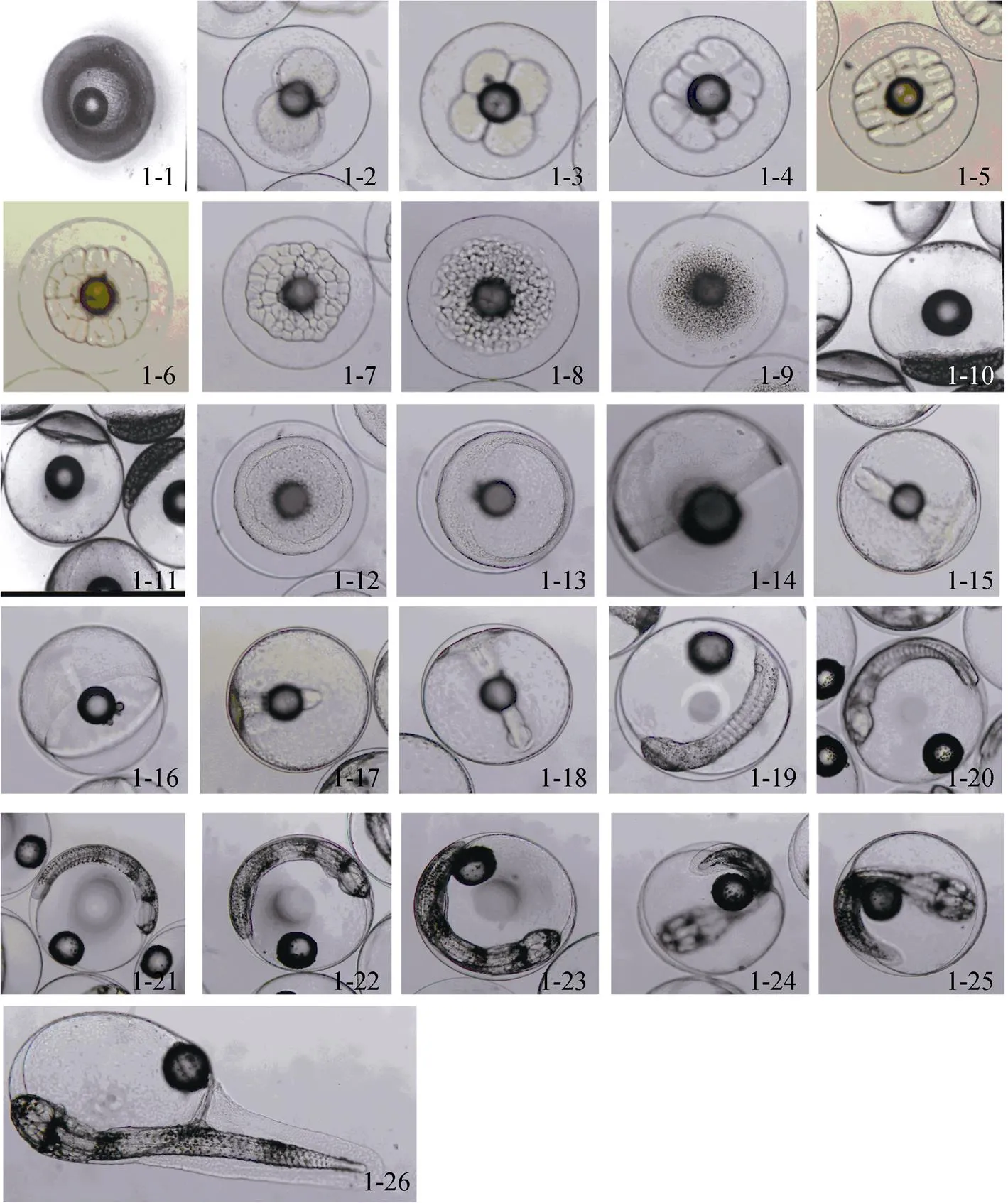
图1 黄姑鱼胚胎发育
1-1. 受精卵, ×40; 1-2. 2细胞期, ×40; 1-3. 4细胞期, ×40; 1-4. 8细胞期, ×40; 1-5.16细胞期, ×40; 1-6. 32细胞期, ×40; 1-7. 64细胞期, ×40; 1-8. 多细胞期, ×40; 1-9. 桑葚期, ×40; 1-10. 高囊胚期, ×40; 1-11. 低囊胚期, ×40; 1-12. 原肠早期, ×40; 1-13. 原肠中期, ×40; 1-14. 原肠晚期, ×32; 1-15. 胚体形成, ×40; 1-16. 胚孔封闭, ×40; 1-17. 眼泡出现期, ×40; 1-18. 肌节出现期, ×40; 1-19. 色素形成, ×40; 1-20. 晶体形成, ×40; 1-21. 尾芽期, ×40; 1-22. 心跳期, ×40; 1-23. 肌肉效应期, ×40; 1-24. 耳石形成, ×40; 1-25. 孵化前期, ×40; 1-26. 初孵仔鱼, ×40
1-1. Fertilized egg, ×40; 1-2. 2-cell stage, ×40; 1-3. 4-cell stage, ×40; 1- 4. 8-cell stage, ×40; 1-5. 16-cell stage, ×40; 1-6. 32-cell stage, ×40; 1-7. 64-cell stage, ×40; 1- 8. Multi-cell stage, ×40; 1-9. Morula stage, ×40; 1-10. High blastula stage, ×40; 1-11. Low blastula stage, ×40; 1-12. Early gastrula, ×40; 1-13. Middle gastrula, ×40; 1-14. Late gastrula, ×32; 1-15. Embryo body formation, ×40; 1-16. Closure of blastopore, ×40; 1-17. Eye vesicle stage, ×40; 1-18. Muscle burl stage, ×40; 1-19. Formation of pigment, ×40; 1-20. Formation of eye lens, ×40; 1-21. Caudal bud stage, ×40; 1-22. Heart beating stage, ×40; 1-23. Muscle contraction, ×40; 1-24. Formation of otolish, ×40; 1-25. Pre-hatching stage, ×40; 1-26. Newly hatched larvae, ×40
2 结果
2.1 胚胎发育
黄姑鱼受精卵(图1)为圆球形, 卵径0.83 mm±0.018 mm, 中央1个油球, 油球径0.24 mm±0.012 mm。在23.2℃±0.15℃、盐度25.7、pH 8.21条件下, 黄姑鱼胚胎发育划分为卵裂期、囊胚期、原肠期、神经胚期和器官形成期5个阶段, 历时22 h59 min完成整个胚胎发育孵化出膜, 其详细发育阶段特征和时间见表1。
2.2 温度对孵化时间、孵化率、初孵仔鱼的影响
在实验盐度为25.7条件下, 实验温度对黄姑鱼的孵化时间和初孵仔鱼有显著影响(图2)。28℃条件下, 黄姑鱼受精卵孵化最快, 历时19 h 12min孵化出膜, 18℃组孵化最慢, 历时29 h15 min才能孵化出膜。24、26和28℃实验组, 进入心跳期的时间相差不大, 26℃组器官形成速度比24℃组快, 18℃组最慢。
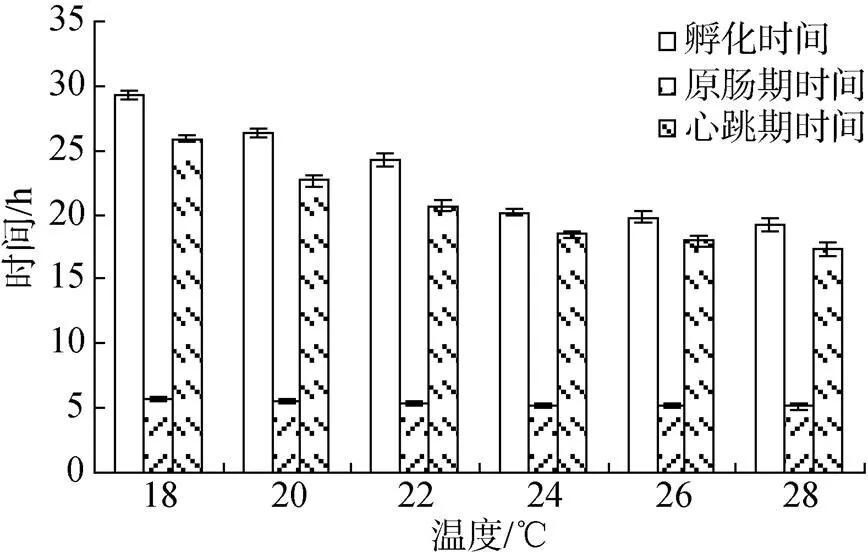
图2 温度对黄姑鱼不同孵化阶段时间的影响
由表2可见, 不同温度组黄姑鱼孵化率和畸形率差异不大, 18~28℃范围内, 黄姑鱼受精卵孵化率98%~100%, 畸形率0%~1%。由表3可见, 水温18~28℃, 不同温度阶段的温度系数10不同; 20~ 24℃时, 黄姑鱼胚胎发育温度系数10为1.947, 接近2。
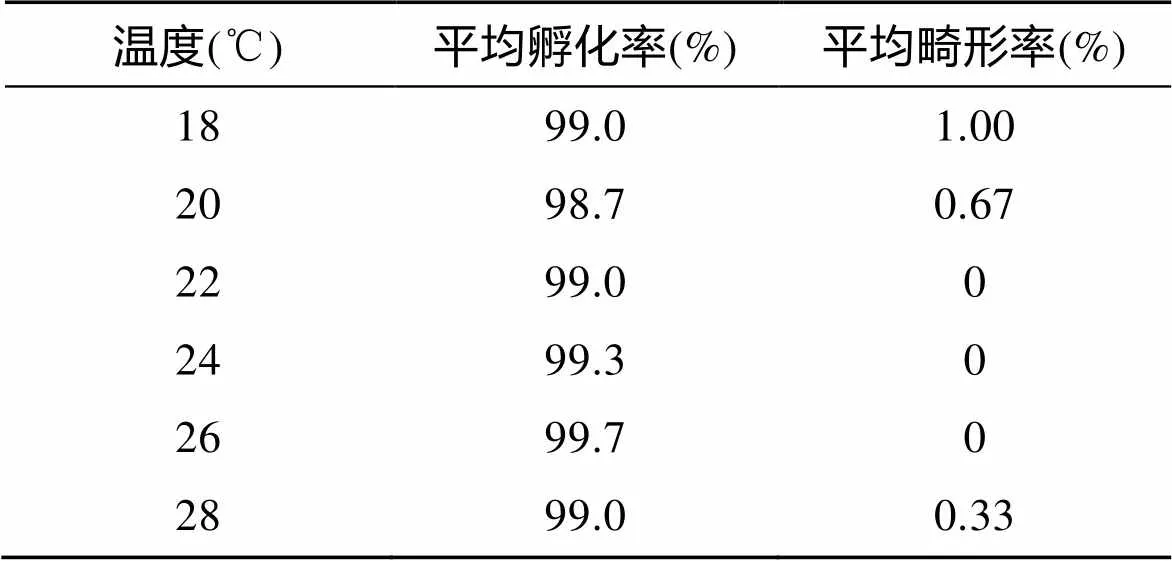
表2 不同温度下黄姑鱼的孵化率和畸形率
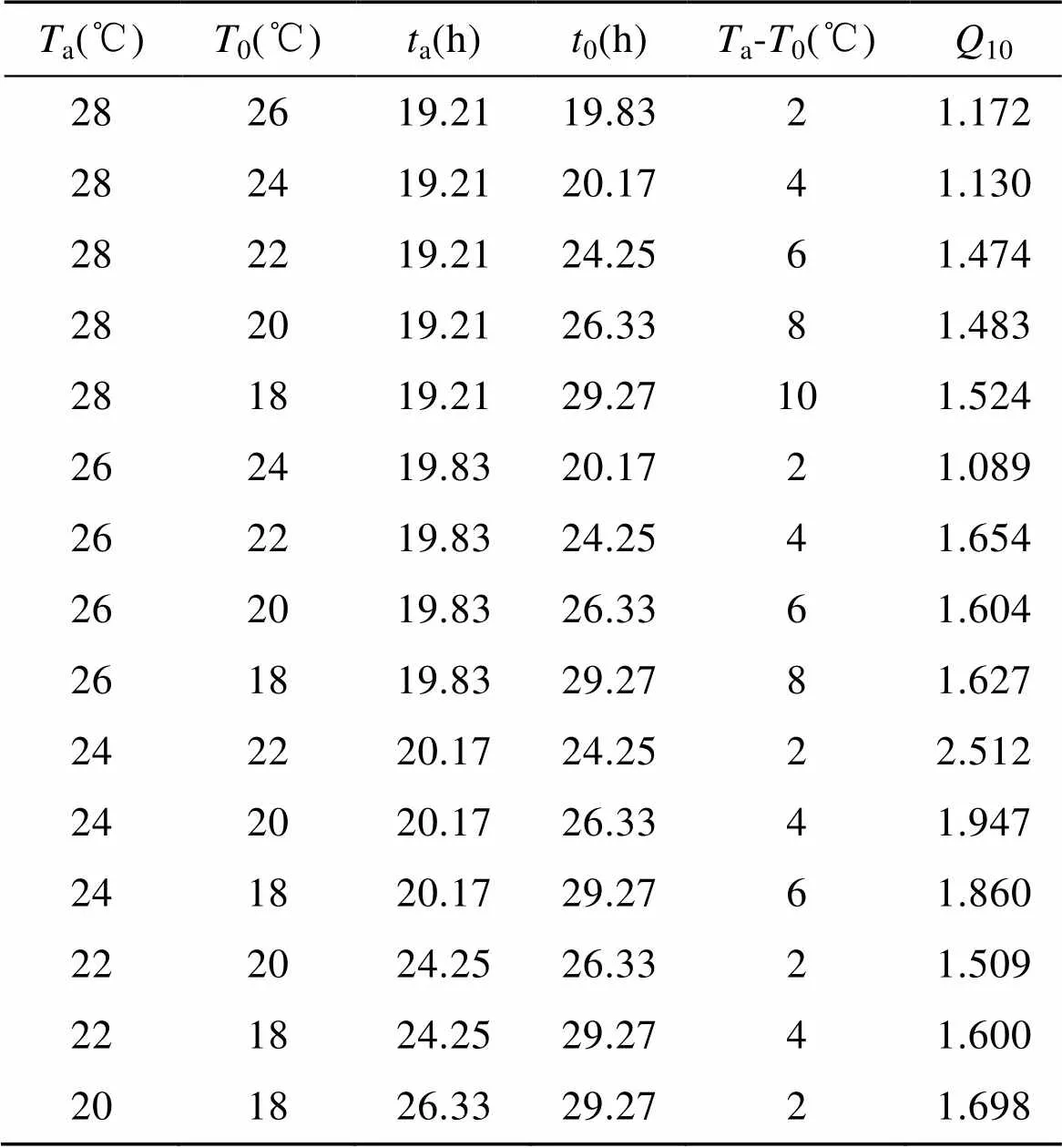
表3 黄姑鱼胚胎发育各温度带的Q10
温度对黄姑鱼初孵仔鱼全长、卵黄囊长径、短径和油球径的影响如图3、图4所示。实验温度在18~28℃范围内, 温度越高其初孵仔鱼的全长越小, 26℃组和28℃组无显著差异, 18、20和22℃组无显著差异, 其他各组间差异显著; 温度越高, 卵黄囊长径和短径越大。温度对黄姑鱼初孵仔鱼油球径无显著影响。
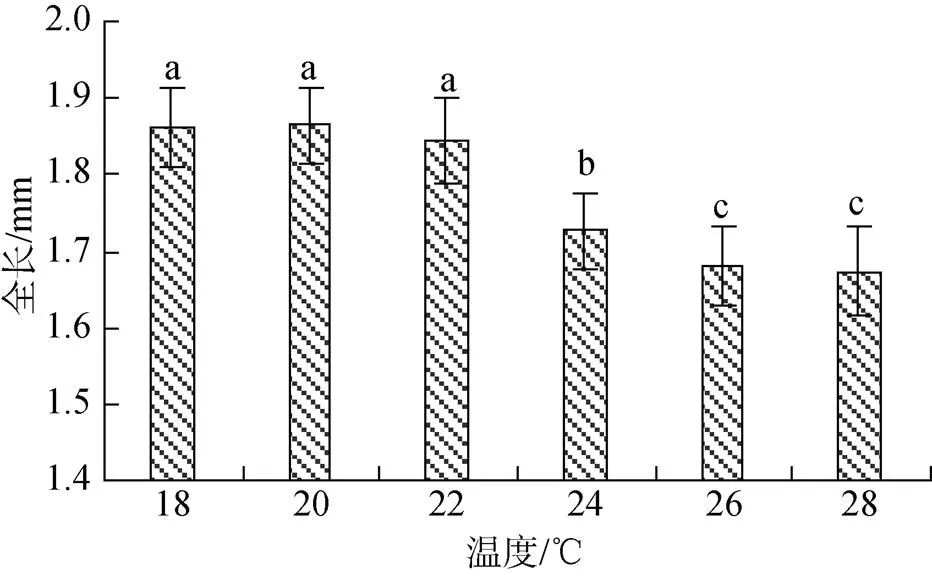
图3 温度对黄姑鱼初孵仔鱼全长的影响
同一字母表示各温度组差异不显著(>0.05), 不同字母表示差异显著(<0.05)。下同
The same letters show that the difference of temperature groups are not significant (>0.05), and the different letters show significant difference (<0.05). The same below
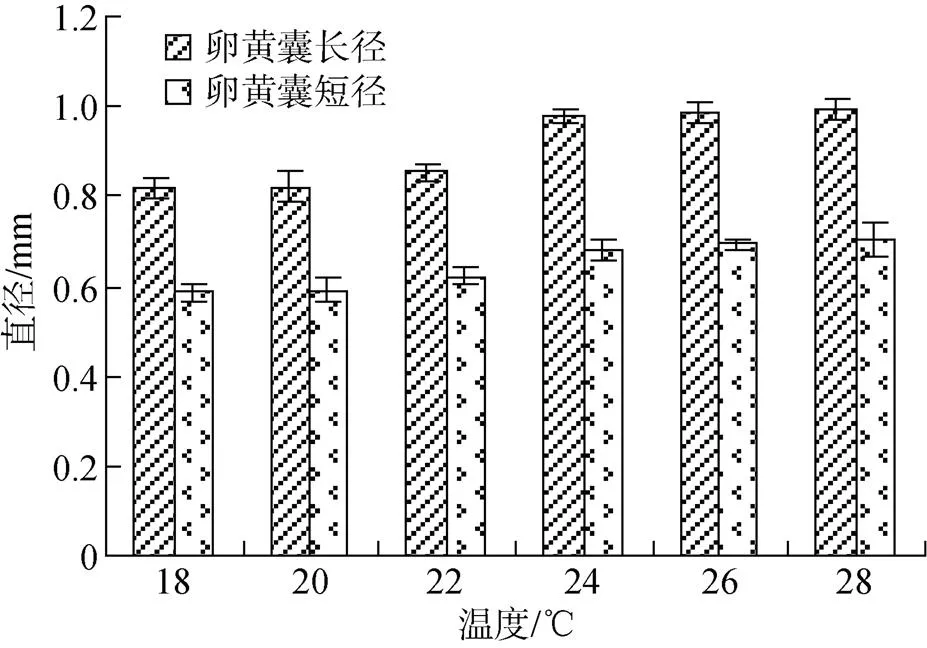
图4 温度对黄姑鱼初孵仔鱼卵黄囊长径和短径的影响
2.3 盐度对受精卵的沉浮分布与胚胎发育的影响
试验结果表明, 在胚胎发育前期, 水体相对静止的状态下, 受精卵在盐度20~24组海水中全部沉底; 在盐度34~40组海水中受精卵全部漂浮在水表层; 盐度26和28组悬浮, 盐度30和32组大多数悬浮, 部分漂在水表层。
盐度对黄姑鱼受精卵孵化时间无显著差异(>0.05), 盐度在20~40范围内, 各盐度组黄姑鱼孵化出膜的时间大致相同。如图5所示, 不同盐度组的孵化率差异显著(<0.05), 其中盐度26~32各实验组孵化率显著高于其他各组, 盐度32组孵化率最高, 达99.67%; 由图6可见, 盐度30组畸形率低于其他组, 盐度24~36各组, 初孵仔鱼畸形率显著低于其他各组。本试验条件下, 盐度低于24或高于36, 则初孵仔鱼畸形率明显增高。
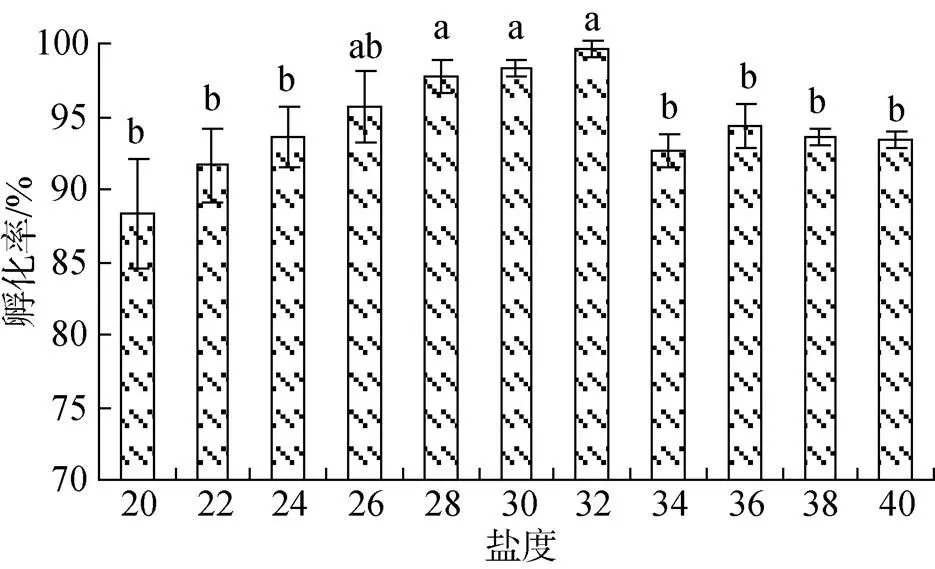
图5 盐度对黄姑鱼孵化率的影响
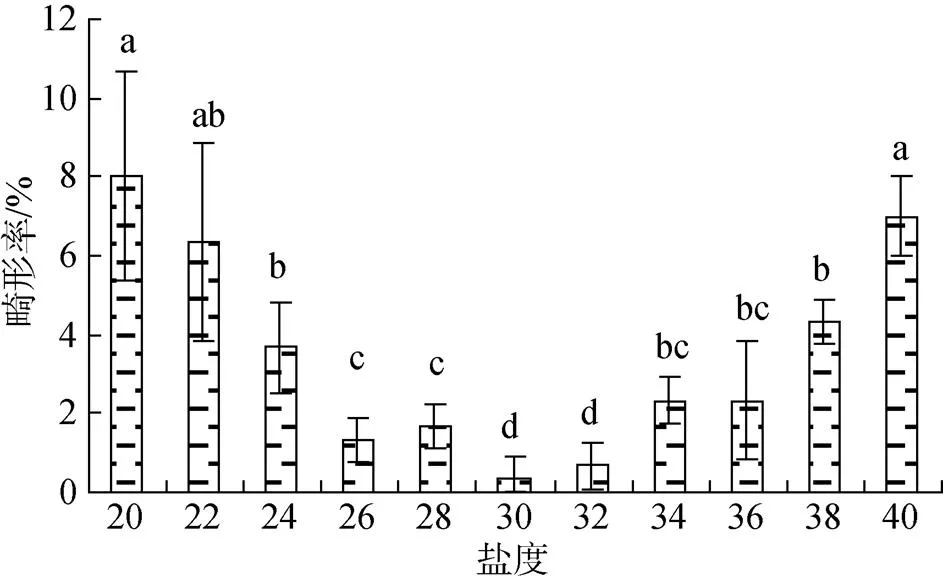
图6 盐度对黄姑鱼畸形率的影响
3 讨论
3.1 温度对受精卵胚胎发育的影响
水温是影响鱼类胚胎发育及其生存、生长和发育的最重要生态因子之一, 不同鱼类的适温范围不同, 同一种鱼类的不同生态类群, 其适温范围亦可能不同。张鑫磊等[11]、陈政强等[12]和夏连军等[13]分别研究了温度与真鲷()、半滑舌鳎()和黄鲷()胚胎发育的关系, 发现胚胎发育时间与水温呈负相关。本研究中, 18~28℃范围内, 黄姑鱼受精卵孵化率和畸形率差异不大, 说明18~28℃在为黄姑鱼适宜的胚胎发育温度范围之内。而18~28℃, 仔鱼孵出的时间越来越短, 说明黄姑鱼受精卵胚胎发育的进展随温度的升高而加快, 与上述研究结果相一致。

3.2 盐度对受精卵及其胚胎发育的影响

[1] 朱元鼎, 罗云林, 伍汉霖. 中国石首鱼类分类系统的研究和新属新种的叙述[M]. 上海: 上海科学技术出版社, 1963: 50-51. Zhu Yuanding, Luo Yunlin, Wu Hanlin. Taxonomic study of sciaenoid fishes and description of a new genus and a new species from China[M]. Shanghai: Shanghai Scientific & Technical Publishers, 1963: 50-51.
[2] 雷霁霖, 樊宁臣, 郑澄伟. 黄姑鱼(Richardson)胚胎发育及仔稚鱼形态特征的初步研究[J].海洋水产研究, 1981, 4(2): 77-84. Lei Jilin, Fan Ningchen, Zheng Chengwei. Preliminery research on embryonic development and morphological characters of larva and juvenile inRichardson[J]. Marine Fisheries Reearch, 1981, 4(2): 77-84.
[3] 陈超, 徐延康, 雷霁霖. 黄姑鱼人工鱼苗初步研究[J]. 水产科学, 1989, 8(1): 7-11. Chen Chao, Xu Yankang, Lei Jilin. Preliminary research on artificial breeding ofRichardson[J]. Fisheries Science, 1989, 8(1): 7-11.
[4] 雷霁霖, 陈超, 徐延康, 等. 黄姑鱼工厂化育苗技术研究[J]. 海洋科学, 1992, 11(6): 5-10. Lei Jilin, Chen Chao, Xu Yankang, et al. Study on industrial breeding techniques ofRichardson[J]. Marine Sciences, 1992, 11(6): 5-10.
[5] 孙忠, 余方平, 程国宝. 舟山近海黄姑鱼室内全人工育苗技术研究[J]. 浙江海洋学院学报, 2005, 24(1): 27-47. Sun Zhong, Yu Fangping, Cheng Guobao. Study on seed production techniques offrom the inshore water of Zhoushan[J]. Journal of Zhejiang Ocean University, 2005, 24(1): 27-47.
[6] 蔡厚才, 林岿璇, 陈传再. 南麂海区黄姑鱼网箱养殖技术研究[J]. 浙江海洋学院学报, 2000, 20(1): 66-69.Cai Houcai, Lin Kuixuan, Chen Chuanzai. Study on cage culture technology of(Richardson) in Nanji Sea Area[J]. Journal of Zhejiang Ocean University, 2000, 20(1): 66-69.
[7] Menezes Maria R, Taniguchi N, Scki S. Degree of intraspecific genetic divergence and variability in three sciaenid species[J]. Japanese Joural of Ichthyology, 1990, 37(1): 39-48.
[8] 韩志强, 高天翔, 王志勇, 等. 黄姑鱼群体遗传多样性的AFLP分析[J]. 水产学报, 2006, 30(5): 640-646. Han Zhiqiang, Gao Tianxiang, Wang Zhiyong, et al. Analysis of genetic diversity ofby AFLP markers[J]. Journal of Fisheries of China, 2006, 30(5): 640-646.
[9] 余方平, 孙忠, 程国宝. 舟山近海黄姑鱼胚胎发育及前期仔鱼形态的观察[J]. 海洋渔业, 2005, 27(4): 265-270. Yu Fangping, Sun Zhong, Cheng Guobao. The embryonic development and pre-larva morphology of Nibea albiflora (Richardson) from the inshore waters of Zhoushan[J]. Marine Fisheries, 2005, 27(4): 265-270.
[10] 邵鑫斌, 闫茂仓, 单乐州, 等. 黄姑鱼对2种驱虫药物的耐受性研究[J]. 水利渔业, 2006, 26(6): 94-96. Shao Xinbin, Yan Maocang, Shan Lezhou, et al. The tolerance ofRichardson to two antiscolic medicines[J]. Reservoir Fisheries, 2006, 26(6): 94-96.
[11] 张鑫磊, 陈四清, 刘寿堂, 等. 温度、盐度对半滑舌鳎胚胎发育的影响[J]. 海洋科学进展, 2006, 24(3): 342-348. Zhang Xinlei, Chen Siqing, Liu Shoutang, et al. Effects of temperature and salinity on embryonic development of tongue sole,Gunther[J]. Advances in Marine Science, 2006, 24(3): 342-348.
[12] 陈政强, 林锦宗, 张雅芝, 等. 温度对秋冬季生殖真鲷胚胎发育及仔、稚鱼存活的影响[J]. 厦门水产学院学报, 1996, 18(1): 63-70. Chen Zhengqiang, Lin Jinzong, Zhang Yazhi, et al. Effects of temperature on embryornic development and larval and post-larval survival in the autumn-winter spawning groups of the red bream,[J]. Journal of Xiamen Fisheries College, 1996, 18(1): 63-70.
[13] 夏连军, 施兆鸿, 王建钢, 等. 温度对黄鲷胚胎发育的影响[J]. 上海水产大学学报, 2006, 15(2): 163-168. Xia Lianjun, Shi Zhaohong, Wang Jiangang, et al. The effect of temperature on embryonic development of(Temminck et Schlegel)[J]. Journal of Shanghai Fisheries University, 2006, 15(2): 163-168.
[14] 杨州, 华洁, 陈晰. 暗纹东方纯胚胎发育历期与温度的关系[J]. 淡水渔业, 2004, 34(2): 6-8. Yang Zhou, Hua Jie, Chen Xi. Relationship between embryonic development period ofand water temperature[J]. Freshwater Fisheries, 2004, 34(2): 6-8.
[15] 谢仰杰, 翁朝红, 管延华. 温度对花尾胡椒鲷胚胎发育的影响[J]. 集美大学学报(自然科学版), 2001, 6(2): 138-143. Xie Yangjie, Weng Zhaohong, Guan Yanhua, et al. Effect of temperature on the embryonic development of yellow spotted grunt,[J]. Journal of Jimei University (Natural Science), 2001, 6(2): 138-143.
[16] 柴学军, 孙敏, 许原剑. 盐度和温度对日本黄姑鱼胚胎发育的影响[J]. 南方水产科学, 2011, 5(7): 43-49. Chai Xuejun, Sun Min, Xu Yuanjian. Effects of temperature and salinity on embryonic development of[J]. South China Fisheries Science, 2011, 5(7): 43-49.
[18] 施兆鸿, 夏连军, 王建钢. 双棘黄姑鱼人工育苗技术的研究[J]. 海洋科学, 2004, 28(10): 34-37. Shi Zhaohong, Xia Lianjun, Wang Jiangang. A study on artificial propagation technique of(Lacp de)[J]. Marine Sciences, 2004, 28(10): 34-37.
[19] 施兆鸿, 复连军, 王建钢, 等. 盐度对黄鲷胚胎发育及早期仔鱼影响[J]. 水产学报, 2004, 28(4): 599-603. Shi Zhaohong, Xia Lianjun, Wang Jiangang, et al. Effect of salinity on embryonic development and larval growth ofTemminck et Schlegel[J]. Journal of Fisheries of China, 2004, 28(4): 599-603.
[20] 施兆鸿, 陈波, 彭士明, 等. 盐度胁迫下点带石斑鱼()胚胎及卵黄囊仔鱼的形态变化[J]. 海洋与湖沼, 2008, 39(3): 222-227. Shi Zhaohong, Chen Bo, Peng Shiming, et al. The morphological change under salinity stress in development of yolk sac larvae of[J]. Oceanologia Et Limnologia Sinica, 2008, 39(3): 222-227.
[21] 徐永江, 柳学周, 马爱军, 等. 半滑舌鳎胚胎发育及仔稚鱼生长与盐度的关系[J]. 海洋科学, 2005, 29(11): 39-44. Xu Yongjiang, Liu Xuezhou, Ma Aijun, et al. Effects of salinity on embryonic development and growth of early life stages ofGünther[J]. Marine Sciences, 2005, 29(11): 39-44.
[22] 林锦宗, 黄厦前, 郑金宝, 等. 盐度对秋冬季生殖真鲷的胚胎发育和仔鱼成活的影响[J]. 厦门水产学院学报, 1994, 16(2): 10-15. Lin Jinzong, Huang Xiaqian, Zheng Jinbao, et al. The effects of salinity on the embryonic development and larval survival of the autumn-winter spawning groups of red porgy,(T.et S )[J]. Journal of Xiamen Fisheries College, 1994, 16(2): 10-15.
[23] 陈昌生, 纪荣兴, 黄佳鸣. 高体鰤胚胎、早期仔鱼发育与盐度的关系[J]. 上海水产大学学报, 1997, 6(1): 5-10. Chen Changsheng, Ji Rongxing, Huang Jiaming. The relationship between the salinity and the embryonic, early larval development in[J]. Journal of Shanghai Fisheries University, 1997, 6(1): 5-10.
Embryonic development ofand the effects of temperature and salinity on embryogenesis
HUANG Xian-ke1, 2, SHAN Le-zhou1, 2, YAN Mao-cang1, 2, CHAI Xue-liang1, 2, HU Li-hua1, 2, SHAO Xin-bin1, 2
(1. Zhejiang Mariculture Research Institute, Wenzhou 325005, China; 2. Zhejiang Key Laboratory of Exploitation and Reservation of Coastal Bio-Resource, Wenzhou 325005, China)
This study investigated the embryology and the effects of temperature and salinity on the early development of the potted maigre. The results showed that temperature (18–28℃) significantly influenced the hatching time and the hatched larvae, but the impact on the hatching rate was not significant. The temperature range of 24–28℃ was appropriate for embryonic development. The optimum salinity range was 26–32 for the embryonic development, and higher or lower salinity resulted in a lower hatching rate or higher larval deformity rate. The fertilized eggs sunk in water (at salinity lower than 34), suspended in water (at salinity 26–28), and floated on water (at salinity higher than 34). In addition, according to the results of10calculation, the appropriate water temperature for embryonic development was similar to the experimental results.
; embryonic development; temperature; salinity
(本文编辑: 谭雪静)
S917.4
A
1000-3096(2017)07-0044-07
10.11759//hykx20160920003
2016-09-20;
2016-11-20
温州市科技计划项目(N20140039, N20150015)
[Wenzhou Science and Technology Project, No.N20140039, N20150015]
黄贤克(1981-), 男, 浙江乐清人, 工程师, 硕士, 主要从事海水养殖研究, 电话: 13757788255, E-mail: hxkdu@163.com; 闫茂仓, 通信作者, 电话: 13587771729, E-mail: yanmaocang@163.com
Sep. 20, 2016
